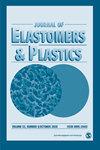甘油处理的聚丙烯/炭黑纳米复合材料:电学、流变学、热学和机械性能分析
IF 1.6
4区 材料科学
Q4 MATERIALS SCIENCE, MULTIDISCIPLINARY
引用次数: 0
摘要
以甘油三酯和蓖麻油为羟基功能分散剂,马来酸酐接枝聚丙烯(MAgPP)为相容剂,以炭黑(CB)纳米颗粒熔融共混制备了导电聚丙烯(PP)纳米复合材料。首先,通过电学分析研究了不同剂量的炭黑纳米颗粒和分散剂对PP/炭黑纳米复合材料的电导率的影响。结果表明,蓖麻油对电导率无显著影响。然而,通过电学、流变学、热学和机械性能的测量以及形态学研究,验证了3 wt%甘油负载的效率。与不添加甘油的纳米复合材料(体积电导率为1.8 × 10−6 S/cm)相比,添加3wt %甘油的含12wt % CB的PP纳米复合材料的体积电导率显著提高至1.2 × 10−4 S/cm。加入适量的甘油有利于纳米填料在基质中的分散,扫描电镜观察证实了这一点,由于基质内导电途径的形成更好,导致了更高的导电性。此外,在相同浓度的CB纳米填料下,用3 wt%甘油处理的样品具有更高的熔融温度、储存模量(G × o)、复合粘度、拉伸模量和断裂伸长率。这些发现表明,在PP/CB纳米复合材料中加入一定量的高效羟基功能组分(如甘油)是一种很有希望的增强导电性能的方法,同时可以保持甚至改善其他性能。本文章由计算机程序翻译,如有差异,请以英文原文为准。
Glycerol-treated polypropylene/carbon black nanocomposites: Analysis of electrical, rheological, thermal and mechanical properties
Electrically conductive nanocomposites based on polypropylene (PP) were prepared using carbon black (CB) nanoparticles via melt blending in the presence of glycerol and castor oil as hydroxyl functional dispersing aids and maleic anhydride–grafted polypropylene (MAgPP) as a compatibilizer. Initially, electrical conductivity of PP/CB nanocomposites with different dosages of both CB nanoparticles and dispersing aids were investigated through electrical analysis. Results indicated that castor oil had no beneficial effects on electrical conductivity. However, the efficiency of 3 wt% loading of glycerol was verified through measurements of electrical, rheological, thermal and mechanical properties as well as by morphological studies. The volume electrical conductivity value of PP nanocomposites containing 12 wt% CB significantly enhanced to 1.2 × 10 −4 S/cm by adding 3 wt% glycerol in compared with nanocomposite without glycerol with the volume conductivity value of 1.8 × 10 −6 S/cm. Incorporation of optimum amount of glycerol favoured the dispersion of nanofiller in the matrix which was confirmed by scanning electron microscopy observations, leading to higher conductivity due to better formation of conductive pathways within the matrix. Additionally, at the same concentration of CB nanofiller, samples treated with 3 wt% glycerol showed higher melting temperatures, storage modulus ( Gˊ), complex viscosity, tensile modulus and elongation at break. These findings indicate that adding an optimum amount of an efficient hydroxyl functional component like glycerol into PP/CB nanocomposite can be a promising way to enhance the electrically conductive performance while other properties could be maintained well or even improved.
求助全文
通过发布文献求助,成功后即可免费获取论文全文。
去求助
来源期刊

Journal of Elastomers and Plastics
工程技术-材料科学:综合
CiteScore
3.30
自引率
5.90%
发文量
41
审稿时长
6 months
期刊介绍:
The Journal of Elastomers and Plastics is a high quality peer-reviewed journal which publishes original research on the development and marketing of elastomers and plastics and the area in between where the characteristics of both extremes are apparent. The journal covers: advances in chemistry, processing, properties and applications; new information on thermoplastic elastomers, reinforced elastomers, natural rubbers, blends and alloys, and fillers and additives.
 求助内容:
求助内容: 应助结果提醒方式:
应助结果提醒方式:


